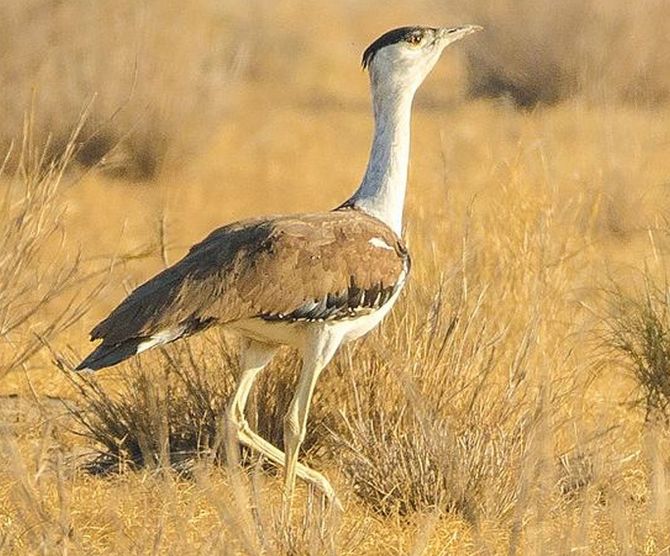SC order would cost the project developers an additional Rs 1.5 trillion for underground transmission.

The Great Indian bustard is at the centre of another impending legal tussle.
The government is planning to move the Supreme Court seeking a review of its order that asked Gujarat and Rajasthan to lay transmission lines linked to solar power units underground so as to not pose any threat to the endangered bird.
The ministry of new and renewable energy (MNRE) has sought a view from the law ministry and will move the court basing its arguments on estimates showing that the bird’s population was declining even before solar power plants came to the region, said a senior government official requesting anonymity.
According to a study by the MNRE, calculations provided by agencies including the Wildlife Institute of India show that there were 1,000 great Indian bustards in 1966 (the earliest estimates available).
Their population shrank to 200 in 2014 and they now number 300.
“The great Indian bustard’s numbers declined much before solar power units came up in the region, which is barely five-six years ago.
"The government is ready to do a technical feasibility study as well,” said an official, adding that several options besides underground cabling could be considered while setting up the power projects.
In April, the Supreme Court directed the governments of Gujarat and Rajasthan to lay the power transmission lines underground.
It observed that all the low-voltage lines, that is 66 kV and below, should be buried underground and that doing the same with high-voltage lines (130 kV and above) is “difficult but not impossible”.
It set a time period of one year for the same.
The court was responding to a public interest litigation filed by former bureaucrat M K Ranjitsinh along with The Corbett Foundation, wildlife activists Piraram Bishnoi from Rajasthan and Santosh Martin from Karnataka, and Gujarat-based birder Navinbhai Bapat.
The petitioners urged that the great Indian bustard is a “critically endangered” bird, so to aid its conservation efforts overhead lines should be avoided.
Close to 60 Gw of solar power capacity stands to be impacted by this judgment, according to the MNRE.
At stake, according to the Rajasthan government, is 95 Gw — which is the total solar potential of the state.
“According to our records, only six birds have died as a result of collisions with solar panels or lines since the projects came up.
"The judgment has adversely affected the potential of renewable energy in Rajasthan.
"The land in question is huge. We are committed to saving the bird, which is native to our state, but the judgment should cover its priority area and not potential area,” said a senior executive of the Rajasthan Renewable Energy Corporation Ltd.
Among the heaviest of flying birds, the great Indian bustard is present mainly in the two states.
Its priority area is 13,000 sq km in Rajasthan and 477 sq km in Gujarat, while the potential area is 78,500 sq km in Rajasthan and 2,108 sq km in Gujarat.
The Supreme Court order pertains to both.
Senior officials said the Rajasthan government is “exploring various legal and administrative options to prevent the project developers from incurring a high cost of undertaking solar projects”.
The MNRE has estimated that it would cost the project developers an additional Rs 1.5 trillion for underground transmission.
The National Solar Energy Federation of India (NSEFI), whose members include developers impacted by the court judgment, is drafting options that could be explored to protect the bird while constructing the plants.
These include bird diverters, aerial bunch cables and line markers.
The MNRE has also considered these ideas for its review petition.
Subrahmanyam Pulipaka, chief executive officer of NSEFI, told Business Standard that it has reviewed 52 case studies across 30 countries to learn best practices to mitigate bird collisions.
The study, reviewed by this paper, observed that solutions such as bird diverters, route planning and dedicated infrastructure related to the birds on transmission lines result in “more than 90 per cent decrease in bird mortality rate”.











